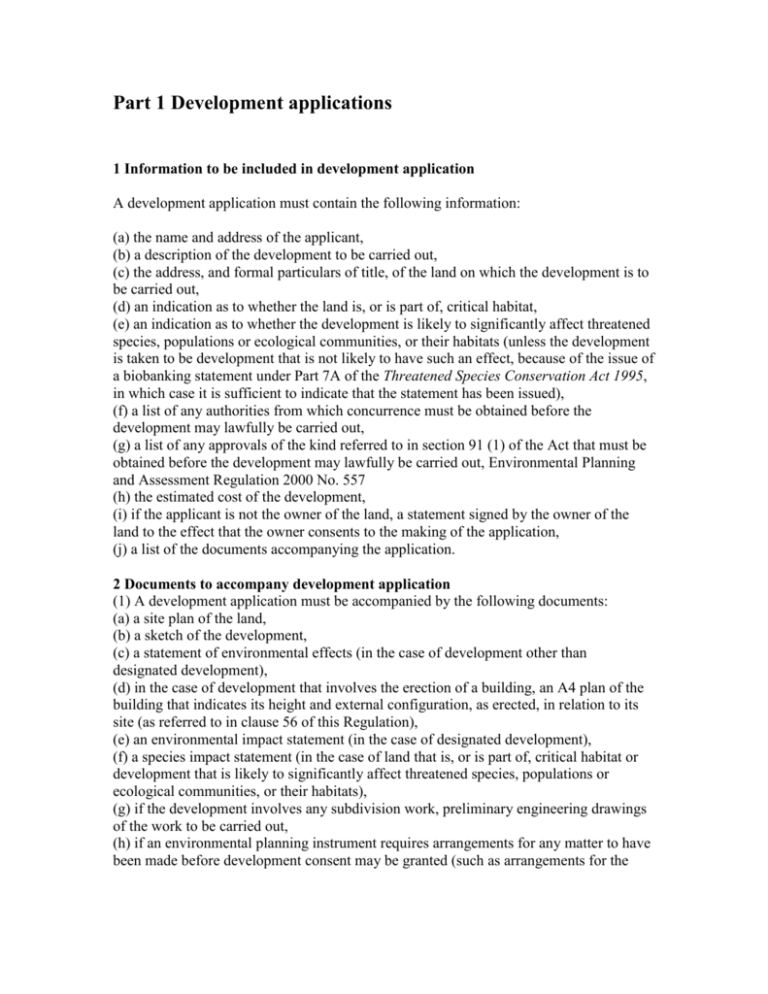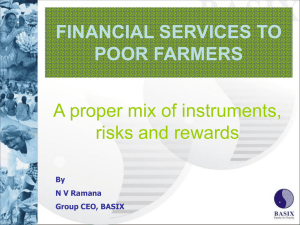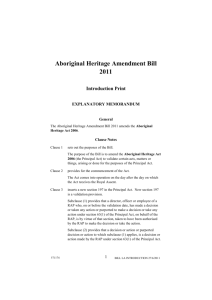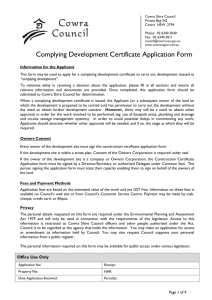Part 1 Development applications
advertisement

Part 1 Development applications 1 Information to be included in development application A development application must contain the following information: (a) the name and address of the applicant, (b) a description of the development to be carried out, (c) the address, and formal particulars of title, of the land on which the development is to be carried out, (d) an indication as to whether the land is, or is part of, critical habitat, (e) an indication as to whether the development is likely to significantly affect threatened species, populations or ecological communities, or their habitats (unless the development is taken to be development that is not likely to have such an effect, because of the issue of a biobanking statement under Part 7A of the Threatened Species Conservation Act 1995, in which case it is sufficient to indicate that the statement has been issued), (f) a list of any authorities from which concurrence must be obtained before the development may lawfully be carried out, (g) a list of any approvals of the kind referred to in section 91 (1) of the Act that must be obtained before the development may lawfully be carried out, Environmental Planning and Assessment Regulation 2000 No. 557 (h) the estimated cost of the development, (i) if the applicant is not the owner of the land, a statement signed by the owner of the land to the effect that the owner consents to the making of the application, (j) a list of the documents accompanying the application. 2 Documents to accompany development application (1) A development application must be accompanied by the following documents: (a) a site plan of the land, (b) a sketch of the development, (c) a statement of environmental effects (in the case of development other than designated development), (d) in the case of development that involves the erection of a building, an A4 plan of the building that indicates its height and external configuration, as erected, in relation to its site (as referred to in clause 56 of this Regulation), (e) an environmental impact statement (in the case of designated development), (f) a species impact statement (in the case of land that is, or is part of, critical habitat or development that is likely to significantly affect threatened species, populations or ecological communities, or their habitats), (g) if the development involves any subdivision work, preliminary engineering drawings of the work to be carried out, (h) if an environmental planning instrument requires arrangements for any matter to have been made before development consent may be granted (such as arrangements for the provision of utility services), documentary evidence that such arrangements have been made, (i) if the development involves a change of use of a building (other than a dwelling-house or a building or structure that is ancillary to a dwelling-house): (i) a list of the Category 1 fire safety provisions that currently apply to the existing building, and (ii) a list of the Category 1 fire safety provisions that are to apply to the building following its change of use, (j) if the development involves building work to alter, expand or rebuild an existing building, a scaled plan of the existing building, (k) if the land is within a wilderness area and is the subject of a wilderness protection agreement or conservation agreement within the meaning of the Wilderness Act 1987, a copy of the consent of the Minister for the Environment to the carrying out of the development, (l) in the case of development to which clause 2A applies, such other documents as any BASIX certificate for the development requires to accompany the application, Environmental Planning and Assessment Regulation 2000 No. 557 (m) in the case of BASIX optional development—if the development application is accompanied by a BASIX certificate or BASIX certificates (despite there being no obligation under clause 2A for it to be so accompanied), such other documents as any BASIX certificate for the development requires to accompany the application. (2) The site plan referred to in subclause (1) (a) must indicate the following matters: (a) the location, boundary dimensions, site area and north point of the land, (b) existing vegetation and trees on the land, (c) the location and uses of existing buildings on the land, (d) existing levels of the land in relation to buildings and roads, (e) the location and uses of buildings on sites adjoining the land. (3) The sketch referred to in subclause (1) (b) must indicate the following matters: (a) the location of any proposed buildings or works (including extensions or additions to existing buildings or works) in relation to the land’s boundaries and adjoining development, (b) floor plans of any proposed buildings showing layout, partitioning, room sizes and intended uses of each part of the building, (c) elevations and sections showing proposed external finishes and heights of any proposed buildings, (d) proposed finished levels of the land in relation to existing and proposed buildings and roads, (e) proposed parking arrangements, entry and exit points for vehicles, and provision for movement of vehicles within the site (including dimensions where appropriate), (f) proposed landscaping and treatment of the land (indicating plant types and their height and maturity), (g) proposed methods of draining the land, (h) in the case of development to which clause 2A applies, such other matters as any BASIX certificate for the development requires to be included on the sketch, (i) in the case of BASIX optional development—if the development application is accompanied by a BASIX certificate or BASIX certificates (despite there being no obligation under clause 2A for it to be so accompanied), such other matters as any BASIX certificate for the development requires to be included on the sketch. (4) A statement of environmental effects referred to in subclause (1) (c) must indicate the following matters: (a) the environmental impacts of the development, (b) how the environmental impacts of the development have been identified, (c) the steps to be taken to protect the environment or to lessen the expected harm to the environment, Environmental Planning and Assessment Regulation 2000 No. 557 (d) any matters required to be indicated by any guidelines issued by the DirectorGeneral for the purposes of this clause. (5) The species impact statement referred to in subclause (1) (f) is not required in relation to the effect of the development on any threatened species, populations or ecological communities, or their habitats, if, because of the issue of a biobanking statement under Part 7A of the Threatened Species Conservation Act 1995, the development is taken to be development that is not likely to significantly affect those threatened species, populations, ecological communities, or their habitats. (6) In the case of development to which clause 2A applies, the explanation referred to in subclause (5) need not deal with the design quality principles referred to in that paragraph to the extent to which they aim: (a) to reduce consumption of mains-supplied potable water, or reduce emissions of greenhouse gases, in the use of the building or in the use of the land on which the building is situated, or (b) to improve the thermal performance of the building.











